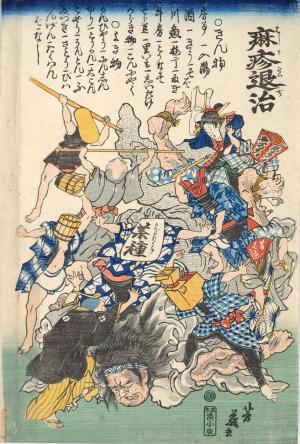Vanquishing the Measles(Hashikataiji)
Painted by Utagawa Yoshifuji 1862(Bunkyū 2) Tokyo Shiryō Collection 778-C12
Colored woodblock prints known as hashika-e or "measles pictures" were printed in Edo, and many are still in existence today. Hashika-e featured various types of illustrations together with textual information on topics such as the things measles patients should avoid, medicines, and charms to alleviate symptoms. This picture shows an anthropomorphized measles deity being vanquished by people of various occupations affected by the disease.
Measles outbreaks occurred during the Edo period at intervals of between 10 and 30 years. The most serious was the nationwide epidemic of 1862. Colored woodblock prints known as hashika-e or "measles pictures" were printed in Edo, and many are still in existence today. Hashika-e featured various types of illustrations together with textual information on topics such as the things measles patients should avoid, medicines, and charms to alleviate symptoms. This picture shows an anthropomorphized measles deity being vanquished by people of various occupations affected by the disease. The medicine bag that is covering the measles deity represents the doctors and pharmacists that would have profited from the outbreak. Above the illustration is a list of foods and habits to be avoided, including alcohol, bathing, moxibustion, and buckwheat, together with recommended foods such as carrot, daikon radish, and sugar. These kinds of measles-related knowledge was popularized through hashika-e and curative texts. While places such as public baths and barbers went out of business, doctors and pharmacists experienced a boom, the prices of foods thought to be effective against the measles rose sharply. As a result the economy was thrown into disarray.


